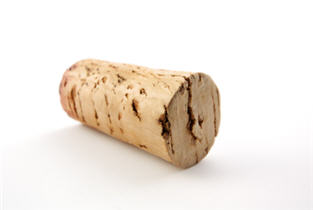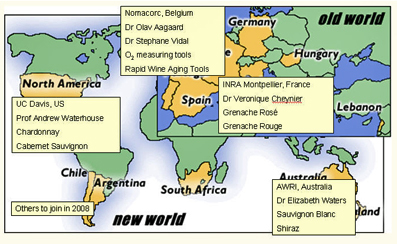

Does the threat of cork taint raise the possibility that wine corks are goners? The research continues with interesting results about consumers' sensory observations of aroma, taste, and mouthfeel.
Getting Closure
The continuing search for the best way to seal the bottle
by
Eleanor & Ray Heald
January 18, 2008

 worse issue with TCA [the chief cause of cork taint is the presence of 2,4,6-trichloroanisole or TCA] is that the compound may exist in a wine at a subliminal level, such that the fruit character of the wine is killed, resulting in a 'dull' wine that has no redeeming graces," Vare notes. "In this case, the consumer does not recognize the 'corked' issue but instead blames the producer. Enter Vare Vineyards. As a brand new winery offering a variety of wines [such as] Ribolla Gialla - that few people have heard of, let alone tried - we cannot afford the exposure to TCA in a subliminal situation."
worse issue with TCA [the chief cause of cork taint is the presence of 2,4,6-trichloroanisole or TCA] is that the compound may exist in a wine at a subliminal level, such that the fruit character of the wine is killed, resulting in a 'dull' wine that has no redeeming graces," Vare notes. "In this case, the consumer does not recognize the 'corked' issue but instead blames the producer. Enter Vare Vineyards. As a brand new winery offering a variety of wines [such as] Ribolla Gialla - that few people have heard of, let alone tried - we cannot afford the exposure to TCA in a subliminal situation."
Vare explained that he wants consumers to enjoy this new varietal wine and not be put off by a matter beyond his control. He took charge by choosing to use a synthetic closure made by Nomacorc. "In truth," he continued, "we could have used a screw cap, but the glass companies have been slow to produce a variety of glass-accepting screw caps, especially in the 500ml size which we use."
Now, there's an issue not brought to light in the earlier postings. Vare suggests that the Nomacorc closures have worked well and he's had no consumer or wine trade kickback. If you've read the earlier APPELLATION AMERICA postings on the topic of wine bottle closures, you also know that winemakers have remarked that screw cap closures do not allow oxygen to reach red wines as they age.
Thus, the question begs: what research has Nomacorc done to lead them to offer a satisfactory closure?
Project Broomstick
 After opening several wines ruined by cork taint in 1993, Belgian businessman and wine aficionado Gert Noël and his son Marc started Project Broomstick, in order to create a closure based on foam extrusion technology. After six years in R&D, they introduced the first Nomacorc closure.
After opening several wines ruined by cork taint in 1993, Belgian businessman and wine aficionado Gert Noël and his son Marc started Project Broomstick, in order to create a closure based on foam extrusion technology. After six years in R&D, they introduced the first Nomacorc closure.
Using the company’s patented co-extrusion manufacturing process, each closure consists of a foamed inner core layer and a flexible outer skin. This method creates uniform closures that yield consistent oxygen (O2) transfer rates. Nomacorc closures look and feel like natural cork and address the problems of cork taint, breakage, crumbling and inconsistent wine preservation.

Nomacorc’s research study was conducted world wide to ensure fair and optimum results.
In May 2007, during a company-hosted interactive seminar at the London International Wine & Spirits Fair, Nomacorc released results of its post-bottling chemistry research illustrating how closures affect wine development. The study [Click here to read how the research was conducted.]
Sensory panelists rated aroma, taste, and mouthfeel perceptions. From this, researchers concluded that each closure type (low, medium or high OTR) led to differences in wine development.
Sauvignon Blanc, with a low OTR closure, had the highest degree of fruit preservation but this was accompanied by the presence of reduced characteristics. The bottle with higher OTR was less fruity but free of reduced character defect. Shiraz with a low OTR closure had both bitter and astringent characteristics. The medium OTR closure was the best balanced and least bitter and also had rounder tannins. The wine with the high OTR was found to have more bitterness yet had the lowest astringency.
Controlling Wine Development
 Winemakers can now use these research results to effectively control wine development in the bottle. No, no, we didn't say ‘manipulate’. The operative word is ’control‘ for positive development and the best showcasing of appellation-identifiable characteristics. These are not wine's dirty little secrets as they have been referenced in some consumer-oriented articles. The closure initiative, which is ongoing in today's wine industry can only lead to better wine experiences for consumers now and in the future.
Winemakers can now use these research results to effectively control wine development in the bottle. No, no, we didn't say ‘manipulate’. The operative word is ’control‘ for positive development and the best showcasing of appellation-identifiable characteristics. These are not wine's dirty little secrets as they have been referenced in some consumer-oriented articles. The closure initiative, which is ongoing in today's wine industry can only lead to better wine experiences for consumers now and in the future.
Aroma descriptors can be traced to specific molecules, which, when identified, can be further linked to their O2 sensitivity and thus it can be determined which closure OTR optimizes desired wine development. Because some aromas are oxygen sensitive and others are not, Nomacorc created a classification system, which groups various aroma classes in relation to their O2 sensitivity, such as (common descriptors in parentheses):
--Mercaptans (passion fruit, grapefruit, gooseberries, cat pee, burned rubber, or even rotten eggs).
--Terpenes (citrus, lime, geranium, lychee, rose, pine or coconut).
--Norisoprenoids (flowery, tobacco, violet, petrol or earthy).
--Esters (candy, tropical fruit, peach, banana or melon).
--Higher alcohols (herbaceous, cranberry, mushroom, vegetal, or malt).
--Volatile Phenols (horse, band-aid, smoky, vanilla, oak or bread).
--Pyrazines (bell pepper, grassy, chocolate, roasted nuts, potato and earthy).
--Anisoles (cardboard, corked and musty).
Using this classification system, Sauvignon Blanc aromas are in the O2-sensitive category (mercaptans) and thus benefit from low O2 exposure. Sauvignon Blanc's reduced characters (volatile sulfur compounds) are found under anaerobic conditions and contact with O2 lowers
The wine industry as a whole has not yet arrived at perfect closure but what seems evident is that there will no longer be a single closure.
the concentration. Thus, a winemaking style influences closure choice. For a reductive winemaking style, which maximizes fruity notes, yet at the risk of producing reductive characters, a winemaker can use a closure with higher OTR to lower the risk of reduced notes while still preserving a wine's fruity character.
In the Shiraz experiment, O2 influences the taste and mouthfeel sensations of bitterness and astringency. Bitterness is associated with smaller tannin molecules (monomers and oligomers) in a wine. Astringency is linked to longer-chain molecules (polymers). Tannin molecules are reactive and constantly changing in size, often breaking into smaller molecular structures or inter-reacting to form longer molecules.
This depolymerize-repolymerize tannin tendency leads to a broad range of molecules of differing sizes, all of which influence a wine’s perceived bitterness and astringency. Mediated by acetaldehyde (detected as ripe fruit aromas) in a wine, tannins can undergo cros










 READER FEEDBACK: To post your comments on this story,
READER FEEDBACK: To post your comments on this story,



